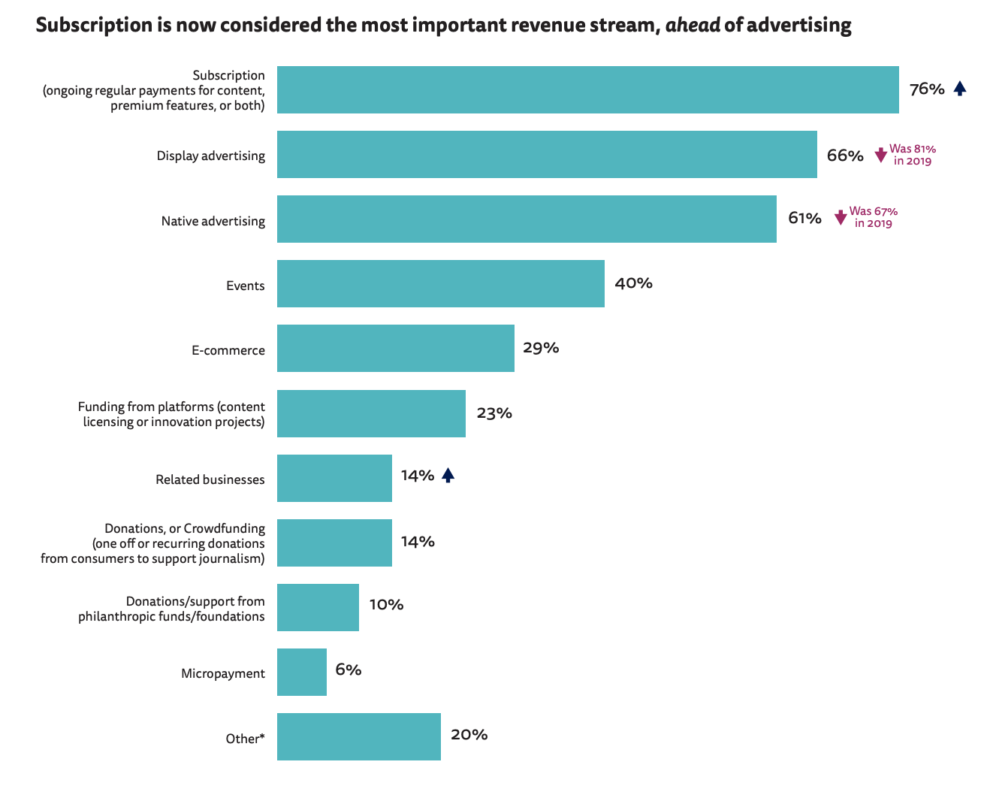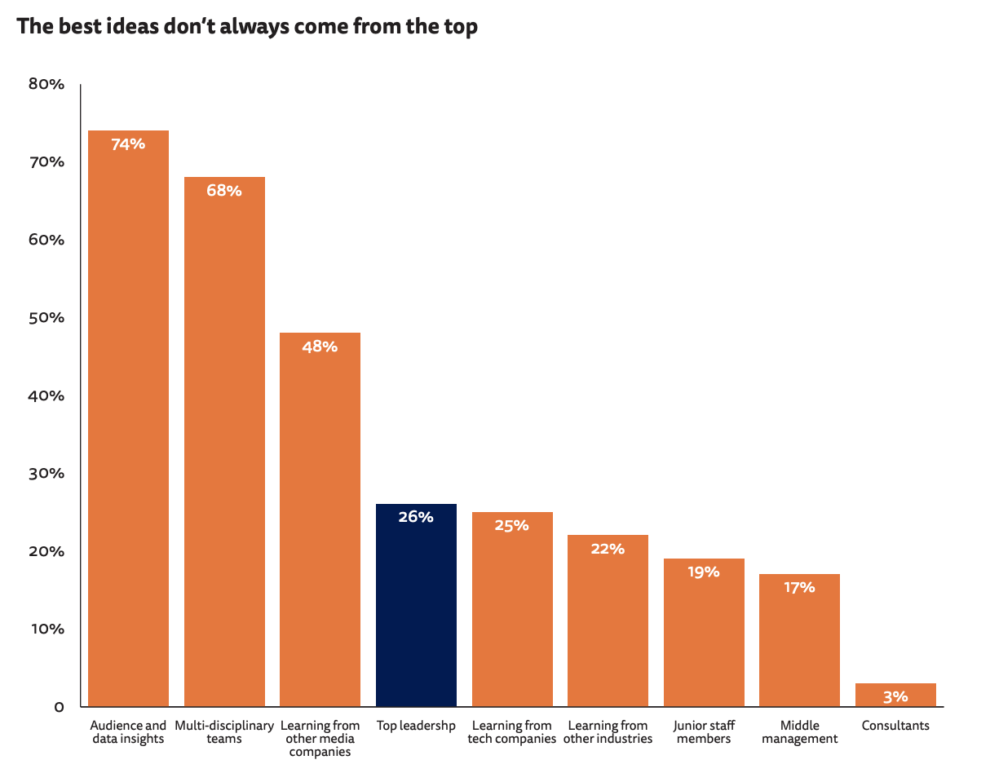In an annual survey of news leaders, the Reuters Institute for the Study of Journalism predicts the trends and changes the media industry will see in the new year. This year’s report is once again full of valuable insights and is definitely well worth a read (full report here). Join us today as we explore the key takeaways to keep in mind this year, straight from the mouths of your industry peers.
Willingness to pay for news does not exist I’d argue, but willingness to pay for convenience, news explained by people I like and feel a connection to, and a sense of belonging does exist.
Lea Korsgaard, Editor-in-Chief at Zetland
Subscriptions come out on top
One of the key takeaways this year is the ever growing importance of subscriptions for sustainable business models in journalism. For the first time, digital subscriptions come out as an important revenue focus with 76% of news executives valuing subscription revenue over display and native advertising. This is a big change from the last time this question was asked, with the reverse being true in 2018.
We saw the importance of subscriptions in 2020, with already declining advertising revenues taking a nose dive. National titles have been able to grow their subscriber bases last year, with The New York Times adding more than a million net digital subscribers and The Guardian growing subscribers for its paid-for apps by 60%. Success stories like these have led to a sense in the news industry that just large, national titles such as The New York Times and The Guardian can make reader revenues work. Even those that believe local news can prove its value still believe that only a small minority of news publishers overall can succeed with subscriptions.

While such early movers are clearly seeing the benefits of successful subscription strategies now, there is also hope for smaller and more local news organisations. The report finds that smaller publications have started asking for subscriptions or reader donations in the past 12 months, even in countries without the tradition of charging for digital news. In Portugal for example, Impresa Group has been able to increase digital subscriptions by 50% in the past year, with a target of continuing to grow 25-30% this year.
Need to further diversify revenue streams
Still while subscriptions might be the top focus, many publishers believe true success will only come through diversifying their revenue streams. It appears that on average, having a mix of four different revenue streams will be important this year. In addition to subscriptions, advertising will stay an important revenue stream, although on the decline.

Events and e-commerce will be other important revenue streams for publishers this year. As the world turned to online shopping during last year’s lockdowns, more and more publishers have decided to get in on the action, looking more like retailers themselves. Some publishers have created stand alone sites to provide product reviews, such as Wirecutter from The New York Times and IndyBest from The Independent. Other publishers may decide to bundle their subscriptions with different subscription offerings or act as the middleman for newer subscription offerings, as Yahoo does for Netflix and Peloton.
Publishers will further invest in events this year, as for many consumers, especially younger consumers, meaningful experiences will trump the desire for buying new products. While most publishers were able to quickly pivot their existing events strategies to remote opportunities, Reuters predicts that the hunger for face-to-face interaction will impact remote event strategies this year with a return to in person events as soon as it is possible. Publishers see bundling paid events with subscriptions as a good way to drive loyalty and reduce churn, while others see open events as a source of valuable audience data and a way to start relationships with new users.
Focus on bottom up innovation
One of the key takeaways in last month’s CEO Roundtable (part of our Future of News webinar series), was how the role of CEO is one of a facilitator. Mediahuis Netherlands CEO Rien van Beemen explained that the people closest to the topics should be making the decisions, as they are the most informed about the particular situation. DuMont Regional Media CEO Thomas Schultz-Homberg agreed with this framing: the role of the CEO is to be an evangelist and empower people to take action, while Chicago Sun-Times CEO Nykia Wright even calls some members of her leadership team her “boss” because there are very few unilateral decisions she will make.
This is a becoming a common belief amongst news CEOs, as the Reuters report shows. According to the survey, the best sources of new ideas are audience and data insights (74%), multi-disciplinary teams (68%), and learning from other media companies (48%). At Twipe we’re proud to further share learnings amongst media companies with our Future of News community.

Another interesting innovation takeaway is that due to limited money available for big new investments, most media organisations will focus on improving existing products and brands (70%) this year, while just 28% will focus more on creating entirely new products.
2021 will be the year of the product manager
Awareness of the importance of product thinking has been growing in recent years, and in 2020 we saw the launch of the News Product Alliance focused on building a community for news product professionals. Media executives see this as well, with more than nine in ten (93%) saying the product manager role is important for coordinating and shaping digital innovation.
Product managers will help news organisations create better user experiences, something that is sorely lagging, especially at the local level.
I’m a big fan and supporter of local news but god their websites are horrendous
— Margaret Sullivan (@Sulliview) January 11, 2021
That’s why many surveyed media executives plan to put more emphasis on the core experience of their websites and apps. To be successful, publishers will move beyond benchmarking their products with other news organisations and instead look at how consumer expectations have been shaped by tech giants such as Amazon and Netflix.
Product will drive the industry because we need to have the customer at the centre of everything. I once heard content is king, but product is queen, and I really agree with that.
Luciana Cardoso, Chief Product Owner at Estadão
Still, there’s a lot of room for education, with the role of product managers still unclear for many in news organisations. As Lucy Kueng explored recently in her report on cultural transformation, the title ‘product manager’ is something borrowed from Silicon Valley. What it means to be a product manager at a technology company is very different than how these roles have evolved at news organisations so far. That’s why less than half (43%) of the surveyed media executives think the product manager role is well understood in their company. Furthermore, many media executives (54%) feel that current product managers often lack the right skills. To be successful going forward, publishers will need to invest in their product teams, in addition to their product experiences.
